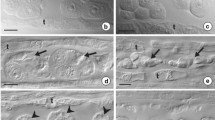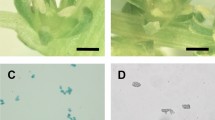Summary
In the locules of fertile Petunia hybrida anthers the in vivo pH during meiosis is 6.8–7.0 and no callase activity can be detected. Towards the end of the tetrad stage, the pH drops to 5.9–6.2 followed by a burst of callase activity. Subsequently, callose in the tetrad walls is digested and the quartets of microspores are released into the anther locules and develop into pollen grains. In the anther locules of one cytoplasmic male sterile (cms) Petunia type the pH drop and strong callase activity are already evident at early meiotic stages. Consequently, the callose already accumulated in the pollen mother cell (PMC) walls is digested and the PMC's cease to develop and are degraded. In another sterile genotype, the pH of the locule remains high (6.8–7.0), no callase activity is detected at the end of tetrad stage and the callose walls remain intact until a very late stage. It is suggested that the timing of callase activity is critical for the normal development of the male gametophyte and that faulty timing may result in male sterility. Measurements of pH in vivo and assays for callase activity in vitro indicate that the low pH is a precondition for the enzyme activity. Furthermore, it is suggested that the activation of callase in vivo is in some way connected with the changes in the pH of the locule.
Similar content being viewed by others
Literature Cited
Brooks, M. H.: Comparative analysis of some of the free amino acids in anthers of fertile and genetic cytoplasmic male sterile sorghum. Genetics 47, 1629–1638 (1962).
Frankel, R., Izhar, S., Nitsan, J.: Timing of callase activity and cytoplasmic male sterility in Petunia. Biochem. Genetics 3, 451–455 (1969).
Fukasawa, H.: Biochemical mechanism of pollen abortion and other alterations in cytoplasmic male sterile wheat. Seiken Ziho 13, 107–111 (1962).
Khoo, U., Stinson, H.: Free amino acid differences between cytoplasmic male sterile and normal fertile anthers. Proc. Nat. Acad. Sci. 43, 603–607 (1957).
Linskens, H. F.: Physiologische Untersuchungen zur Reifeteilung. I. Mitteilung über die Änderung einiger physiologischen Zustandsgrö\en während der Pollenmeiose und Pollenentwicklung von Lilium henryi. Ber. dt. bot. Ges. 69, 353–360 (1956).
Rick, C. M.: Genetics and development of nine male sterile tomato mutants. Hilgardia 17, 599–623 (1948).
Sarvella, P., Stojanovic, B. J., Grogan, C. O.: Amino acids at different growth stages in normal, male-sterile and restored maize (Zea mays L.). Z. Pflanzenz. 57, 361–370 (1967).
Small, J.: Modern Aspects of pH. London: Baillère, Tindall & Cassel Ltd. 1954.
Smith, F., Montgomery, R.: End group analysis of polysaccharides. Methods of Biochem. Analysis 13, 153–212 (1956).
Vasil, I. K.: Physiology and cytology of anther development. Biol. Rev. 4, 327–373 (1967).
Author information
Authors and Affiliations
Additional information
Communicated by H. F. Linskens
Contribution from The Volcani Institute of Agricultural Research, 1970 Series, No. 1709-E.
Supported in part by grant No. FG-Is-171 from the United States Department of Agriculture, under P. L. 480.
Rights and permissions
About this article
Cite this article
Izhar, S., Frankel, R. Mechanism of male sterility in Petunia: The relationship between pH, callase activity in the anthers, and the breakdown of the microsporogenesis. Theoret. Appl. Genetics 41, 104–108 (1971). https://doi.org/10.1007/BF00277751
Received:
Issue Date:
DOI: https://doi.org/10.1007/BF00277751




